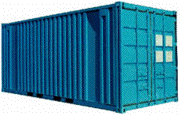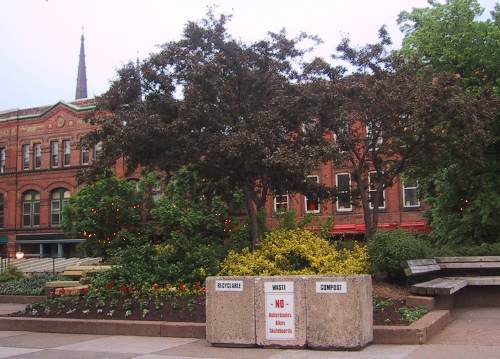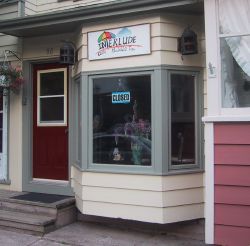 A standard ISO 20 foot freight container has inside dimensions of 19’5” (length) by 7’8” (wide) by 7’9.5” (high). The container itself weighs 4189 pounds, and has a dry capacity of 48,721 pounds, and a volume of 1,165 cubic feet. These are immutable facts, set by the International Organization for Standardization. You can purchase a handbook from the ISO that tells you everything you want to know about shipping containers.
A standard ISO 20 foot freight container has inside dimensions of 19’5” (length) by 7’8” (wide) by 7’9.5” (high). The container itself weighs 4189 pounds, and has a dry capacity of 48,721 pounds, and a volume of 1,165 cubic feet. These are immutable facts, set by the International Organization for Standardization. You can purchase a handbook from the ISO that tells you everything you want to know about shipping containers.
To send a 20 foot container full of food from the U.S. east coast to the port of Rotterdam costs about $1700 US.
The “founding father of the freight container” was Malcolm McLean, who died in 2001. In a tribute to McLean, United States Commissioner of Customs, Robert C. Bonner related the history:
Malcolm McLean invented the shipping container in the 1930s in New Jersey, while sitting at a dock waiting all day for cargo he had carried there in his truck to be reloaded onto a ship. He figured out a better way to pack goods and transport them by sea - which was to secure them in large steel boxes that could be easily loaded onto ships. And in so doing he came up with an idea that changed the face of global trade.
SeaLand, the company that McLean founded, is now Maersk-Sealand, having merged with the Maersk Line in 1999. It’s difficult to drive down any highway, or through any port, anywhere, without seeing a container with Maersk painted on the side.
Quote overheard at Timothy’s at 10:42 a.m. this morning. Speaker was, by appearances, a Holland College policy wonk.
Apparently I have invented a concept: search Google for car free Mondays and, so far, there are no results. Until now!
I woke up this morning with a 9:00 a.m. meeting on my calendar, about a mile away from my house. Usually, I am ashamed to say, attending meetings like this would entail waiting until five minutes before the scheduled time, hopping in my car, and hot tailing it 5 blocks west.
This morning, though, with visions of greenhouse gas emissions dancing in my head, I decided to extract the oft-unused bicycle from the mud room and leave the car at home.
After my meeting, I had a pleasant ride home, with a stop at Timothy’s for some work and an iced mocha cappucino.
After lunch, I got 4 or 5 hours worth of work done, and then realized suddenly that I should rush out to Future Shop to buy a wireless router to feed my neighbours.
Again, usually this would entail about a 4 minute car ride each way, but “Car Free Mondays” now planted firmly in my head, I decided to get the bike out again.
This being a much longer trip than my aging body is used to — and one that entails several minor league hills (some might say “rises”) — I quickly arranged with Steven to make an impromptu visit to the slicedome. This would afford me both the opportunity to tour their empire, but also would provide a convenient excuse to rest my weary body and refuel on water.
The ride out was much easier than I imagined it to be. The “tough bits” — the rise from Shoppers Drug Mart to UPEI, and the hill after the dip on the way up to Staples — weren’t that hard at all. Even the route back up North River Road, although pockmarked with various construction debris, wasn’t all that hard.
Here’s what I learned and gained in today’s experiment:
- I burned about 259 calories; says here that’s about 0.44 Big Macs worth.
- I saved about 1/5 of a gallon of gasoline, saving me about 50 cents.
- I saved the planet from about 1.5 kilograms of greenhouse gases.
- I kept one car out of both early morning and late afternoon Charlottetown traffic, making the ride easier for everyone who didn’t leave the car at home.
- I realized just how much smog there really is in Charlottetown; I challenge anyone to stand at the corner of Allen Street and University Ave. and breath in deeply at 4:00 p.m. on a weekday and not be shocked at the result.
- I discovered that Charlottetown is not a “bike friendly city” in terms of its infrastructure None of the roads I took had a bike lane. The area where bikes are expected to ride, between the sidewalk and traffic, is often full of holes, rocks, and culvert construction.
- That said, I learned that Charlottetown drivers, at least in my experience today, are quite bike tolerant. I was turning left in their turn lanes, make them wait for me, forcing them to slow down, and I never heard a honk of the horn or an unkind word spoken or yelled.
- I saw one other person on a bicycle during my entire journey — a woman riding up around UPEI.
I think I’m going to try and stick to a regime of Car Free Mondays for the summer, and see how it goes.
Care to join me?
The Confederation Centre of the Arts is in the midst of a well-deserved renovation. The Confederation Centre Public Library has been spruced up. Spring has sprung, summer’s here, the trees are out, the landscaping is in full spleandour.
And this is the view from the plaza, sitting on a brand new bench, looking out over Victoria Row:

Couldn’t we muster a couple of hundred extras dollars for some design and construction work so that our garbage doesn’t look like it’s being stored in concrete coffins with poor typography.
Don’t get me started on the “No Skateboards Bikes Rollerblades” thing.
 Stringer David Joseph Malahoff was first to spot Interlude a new café on Kent Street advertising “bubble tea.” Oliver and I took a field trip over this evening to take a look, but they were closed. Peering in the window, things look very interesting. Perhaps all the Charlottetown firefighters will become bubble tea addicts now?
Stringer David Joseph Malahoff was first to spot Interlude a new café on Kent Street advertising “bubble tea.” Oliver and I took a field trip over this evening to take a look, but they were closed. Peering in the window, things look very interesting. Perhaps all the Charlottetown firefighters will become bubble tea addicts now?
In other coffee and tea news: the Formosa Tea House has changed its hours: they’re now open from Noon to 6:00 p.m. (an hour later in both opening and closing). My friend Ann commented that if they extend forward by about another six hours, they’ll hit the sweet spot for my patronage.
Also, renovations to the former Uncommon Grocer space on Queen St. continue, as Cora’s Breakfast and Lunch readies for operation.
Keep eating…
I have become addicted to bluegrass music, and have set my virtual radio dial to BluegrassCountry.org. Go figure.
The Angus TeleManagement Group reports in today’s Telecom Update:
AT&T Canada has announced its new name three months earlier than required by its deal with AT&T Corp. The new name, Allstream Inc, is effective immediately: the company can continue describing itself as “formerly AT&T Canada” until December.
The company has a page on their website explaining the new brand.
Will Pate, who I think is wise beyond his years, said something at the last Charlottetown weblogger meeting that has stuck with me. We were talking about the Wifi Charlottetown project, and the notion of locating WiFi hotspots in various cafes and restaurants in the city. Will said this was important because as work intrudes more and more into our leisure time, we need to make work “more leisurely.” This is another way of stating a goal I’ve had for a while, which is having a “vacation like life.” As I sit here typing this in Timothy’s coffee shop, using the Little Mac Shoppe WiFi connection, it’s surprising how, even though I’m doing “work,” it doesn’t feel like it. Somehow being outside of an office, with a phone and a desk and other work trappings makes me about twice as productive; the white noise of the coffee shop hubub makes for a good workspace, I guess. Perhaps this is the greatest selling point downtown Charlottetown (or downtown anywhere) has a workspace: working out and about makes working an obvious thing, and something that is inexorably linked to the community around. Sitting in front of my terminal in my home office, I could be anywhere — in a hotel room in Budapest, in an office tower in Toronto. Sitting here at Timothy’s, I am in Charlottetown, participating in the life of my community. As if on cue, Dwight, who I worked with on a potato project several years ago, and who hails from Emyvale, up the road from our old house in Kingston, and who’s now working for Food Trust PEI, drops in for a coffee. We spend 10 minutes catching up on our current projects, our kids, and so. Dwight goes back to the office, and I pick up where I left off.
I was a participant in the Google AdSense program for 3 days. I made 35 cents. The Terms and Conditions of my agreement with Google prohibit me from revealing the clickthru rates for the ads; the 35 cents should speak for itself in this regard.
In the discussion about my original post on this topic, reader “Wayne” said:
The “in your face” money-grab commercialization has spread far and wide. Perhaps it is the new reality, but nontheless, a sad one, faced every day by us all, everywhere. And, I think it has conditioned us to develop personal filtering systems that require “shock and awe” to penetrate.
And reader “Ken” said:
Freedom of speech does not apply to repetetive viral conditioning from McCains, McDonalds or Coke. Especially when phone ringing, door-bell, horn-tooting anoyances grab for our attention by preying on our conditioning to these alerts.
Both insightful comments. From my end of the bargain, making, on average, 10 cents a day from advertising doesn’t come anywhere near close to compensation for the intrusion of advertising into the writing and reading space. For that matter, I’m not sure how much, if any amount, would warrant this.
In any case, this space now returns to its regularly scheduled ad-free configuration. Apologies for the disruption.
Shaddy’s Shwarma Palace opened the week I arrived on Prince Edward Island, ten years ago. It was the first place I ate dinner. Now it’s for sale. No word on why. Still the best place to get a shish taouk if you like garlic.
Shaddy’s isn’t the only Island restaurant for sale: The Red Rooster, in Crapaud, and The Salad Stop and The Jukebox, both in the Confederation Court Mall, are for sale as well.
 I am
I am